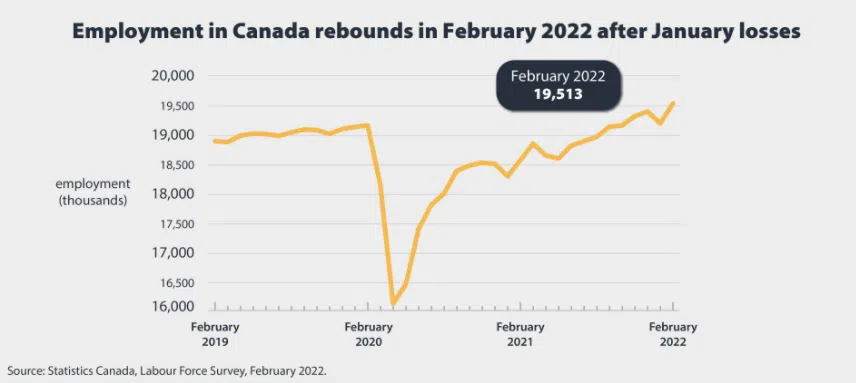Canada’s overall job market improved in February and Atlantic Canada continued to see modest employment gains in three provinces, according to Statistics Canada.
Newfoundland and Labrador, Nova Scotia, and Prince Edward Island all saw employment increases last month, while Statistics Canada noted there was little employment change in New Brunswick.
Employment was up 0.8 percent over January in Nova Scotia, where the province added 3,700 jobs. Prince Edward Island also saw an increase of 3,300 positions last month, up 4.1 percent over January.
Nova Scotia’s unemployment rate improved marginally to 6.6 percent last month, down from January’s seven percent. PEI’s unemployment rate also dipped in February to nine percent, down six percentage points over the previous month.
Employment increased by 9,500, up 4.3 percent over January, in Newfoundland and Labrador, mostly through gains in part-time work.
Meanwhile, Newfoundland and Labrador’s unemployment rate was little changed for February, coming in at 12.3 percent–the highest among all provinces. This month’s jobs report also pegged St. John’s unemployment rate much lower than the rest of the province, at 7.3 percent.
While New Brunswick’s 7.9 percent unemployment rate for February was an improvement over January, at 8.5 percent, there was little change to the province’s overall employment rate.
The unemployment rate was marginally lower in February in Halifax (5.7 percent) and Moncton (6.1 percent), while Saint John’s unemployment rate improved to 7.3 percent, all on a three-month moving average.
Nationally, employment rebounded in February as the country added 337,000 positions, (up 1.8 percent). Those gains were mainly bolstered by the private sector, which more than recovered any January job losses.
National employment rate returns to pre-Covid level for the first time
February’s Labour Force survey also marked the first time Canada’s employment rate returned to pre-pandemic levels, according to StatsCan.
The country’s overall employment rate, (the proportion of the population aged 15 and older who were employed), rose to 61.8 percent in February, a one percent jump. It was the first time the national employment has returned to its pre-February, 2020 level.
StatsCan also noted that while employment had also recovered to its pre-pandemic level in September 2021, the employment rate, a reflection of both the level of employment and the size of the population, has been slower to recover.
Last month saw the national unemployment rate drop to 5.5 percent, the lowest rate surveyed since June 2019, and only narrowly outperformed by May of that same year, which saw a three-year low unemployment rate of 5.4 percent.
February employment gains widespread across industries
Consistent with the relaxing of public health restrictions, the number of people working in the services-producing sector nationally rose by 293,000 in February, which StatsCan says more than recouped January losses.
It was led by a rebound in accommodation and food services (+114,000), information, culture and recreation (+73,000), and retail trade (+21,000), with all three industries accounting for the majority, (70.8 percent) of the net employment gains in the services-producing sector.
Employment in goods-producing sectors also rose (+44,000) in February, marking the third consecutive monthly increase.
Wage growth stumped by inflation
StatsCan noted average hourly wages increased 3.1 percent (+$0.92) year-over-year for February.
Since last fall, and coinciding with strong employment growth, average hourly wages have been on an upward trend on a year-over-year basis, reaching 2.7 percent in December 2021 before falling back to 2.4 percent in January.
In May 2019, when the national unemployment rate fell to record lows, year-over-year wage growth averaged 3.5 percent, and reached 4.6 percent in November of that same year.
The year-over-year wage growth has been drowned by inflation, with the annual measure for Canada recently surpassing 5 percent for the first time since 1991, according to Statistics Canada tracking last month.
Annual inflation rose to 5.1 percent in January, compared to a 4.8 percent gain recorded in December 2021.
For comparison, during the same period last year, the Consumer Price Index, (CPI) increased by one percent on a year-over-year basis.
Canadians find themselves paying significantly more for gasoline (31.7 percent), food (5.7 percent), and housing (6.2 percent).
StatsCan reported that excluding gas, the CPI rose 4.3 percent in January — the fasted pace since the index was introduced in 1999.
Tyler Mclean is a reporter with Huddle, an Acadia Broadcasting content partner.







